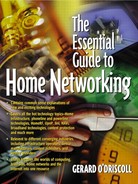IN-FIELD PRODUCT TESTING
In-field testing represents an important step in the development of any communications product because it helps to prove the "real-world" viability of the technology. But it is particularly important for powerline technologies, which are specifically designed to overcome the randomness and complexity of the environment.
In essence, the challenge to powerline communications is to design a product that works in an environment that was never intended for such use. In other words, sending a data signal down a copper wire that carries an electrical current is one hurdle. But it is quite a different technological challenge to produce a universal, low-cost powerline transceiver that operates reliably between all sockets links, in all homes, at all times throughout the day.
The following list highlights some of the key obstacles that a powerline technology will encounter during field trials.
Socket Links
The transceivers must be able to establish connections and maintain transmission bandwidth across all combinations of socket links in a given home. This means that signals may have to jump phases at the circuit breaker and reach opposite sides of the home without attenuating significantly.
Time Variability (Appliance Usage Cycles)
The transceivers must be able to maintain transmission bandwidth consistently over the time cycles that correspond with appliance usage. This means that bandwidth transmission must be maintained even as appliance usage varies throughout the day.
Such usage patterns may involve multiple sources of noise being injected onto the network simultaneously. (Imagine the powerline environment in a home with different family members operating a dishwasher, a blender, and a hair dryer at the same time, compared to that same home when everyone is at work or school.)
Household Demographics
The transceivers must operate across the vast majority of homes in the marketplace. This involves significant variability in size, design, and materials used for the electrical network.
Although in the past many developers were able to achieve high-speed data communications in laboratory environments, none of these technologies evolved into consumer products because they were unable to successfully pass through the stage of in-field testing. The following sections cover some of the newest advancements and innovations from developers in the powerline communications industry, which may bring products enabling speeds of 10 Mbps and beyond as soon as early 2001.
